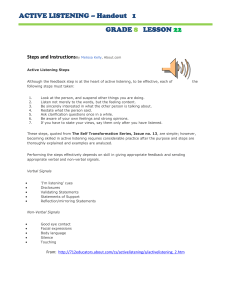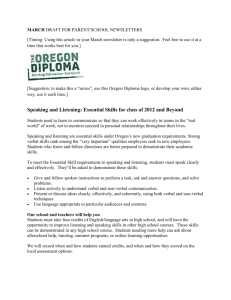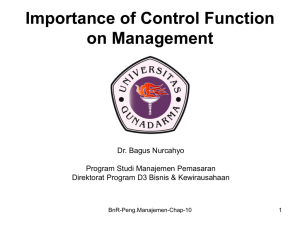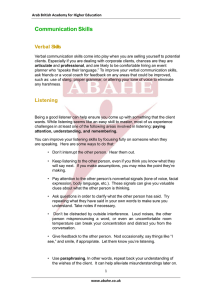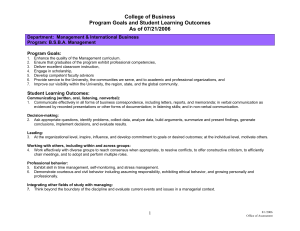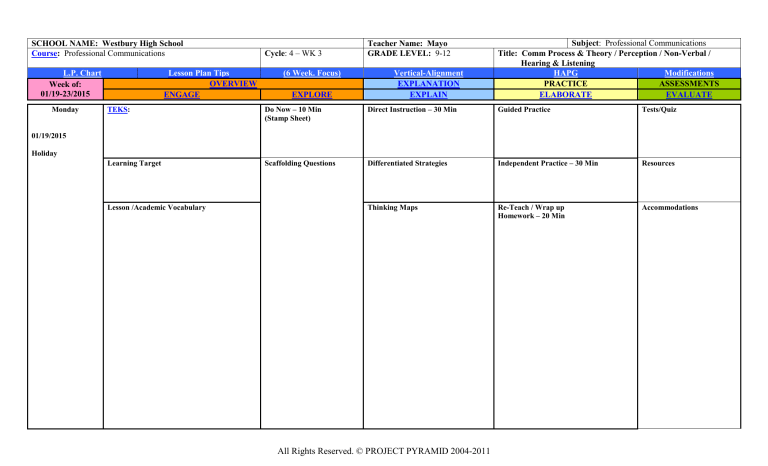
SCHOOL NAME: Westbury High School
Course: Professional Communications
L.P. Chart
Week of:
01/19-23/2015
Monday
Lesson Plan Tips
OVERVIEW
ENGAGE
Cycle: 4 – WK 3
(6 Week. Focus)
EXPLORE
Teacher Name: Mayo
GRADE LEVEL: 9-12
Vertical-Alignment
EXPLANATION
EXPLAIN
Subject: Professional Communications
Title: Comm Process & Theory / Perception / Non-Verbal /
Hearing & Listening
HAPG
Modifications
PRACTICE
ASSESSMENTS
ELABORATE
EVALUATE
TEKS:
Do Now – 10 Min
(Stamp Sheet)
Direct Instruction – 30 Min
Guided Practice
Tests/Quiz
Learning Target
Scaffolding Questions
Differentiated Strategies
Independent Practice – 30 Min
Resources
Thinking Maps
Re-Teach / Wrap up
Homework – 20 Min
Accommodations
01/19/2015
Holiday
Lesson /Academic Vocabulary
All Rights Reserved. © PROJECT PYRAMID 2004-2011
Tuesday
01/21/2014
§110.58. Communication
Applications 1b, 1d, 1e, 1f, 2a, 2c, 2d, 2f, 2g
Do Now – 10 Min
(Stamp Sheet)
Learning Target
Students will submit the
worksheets: “Who are you?”
“50 Facts List” and
“Intrapersonal Inventory.”
Scaffolding Questions
TEKS:
EVEN Day
SW: Participate in the Professional Communications
Course Pre-Assessment.
SW: Continue to participate in the discussion of the
Communication Process & Theory/
Listening & Hearing / Perception / Non-Verbal
Communication.
Lesson /Academic Vocabulary
What is Self Disclosure?
Direct Instruction – 30 Min
Guided Practice
Teacher led discussion with Power
Point Presentation.
Open class discussion.
Differentiated Strategies.
Independent Practice – 30 Min
Resources
Power Point presentation with
discussion content for student notes.
Student notes using prepared note sheet.
Curriculum / Teacher
Materials.
When do you self disclose?
How do we use perception in
our communication?
Using numbered seats for “Cold
Calling” for checking for understanding
& participation.
Thinking Maps
Sender, Receiver, Encoding, Decoding,
Channels, Signs, Symbols, Verbal & NonVerbal Communication, Noise-Physical &
Psychological, Feedback – Spontaneous &
Delayed, Environment – Setting, Situation,
History and Culture, Perception, Self Disclosure
Selective, Critical, Empathetic, & Social
Listening.
Secondary Assignment: Complete the
vocabulary for chapters 2 & 3.
Re-Teach / Wrap up
Homework – 20 Min
Complete the “Communication Self
Inventory” and “Perception” worksheets.
All Rights Reserved. © PROJECT PYRAMID 2004-2011
Tests/Quiz
Accommodations
Oral Instructions, Shortened
Assignments, Guided Practice
and One on One instruction,
Extended Time and Verbal
Instructions.
Wednesday
§110.58. Communication
Applications 1b, 1d, 1e, 1f, 2a, 2c, 2d, 2f, 2g
TEKS:
Do Now – 10 Min
(Stamp Sheet)
Direct Instruction – 30 Min
Guided Practice
Teacher led discussion with Power
Point Presentation.
Open class discussion.
Scaffolding Questions
Differentiated Strategies
Independent Practice – 30 Min
Resources
How do we use perception in
our communication?
Power Point presentation with
discussion content for student notes.
Student notes using prepared note sheet.
Curriculum / Teacher
Materials.
Re-Teach / Wrap up
Homework – 20 Min
Accommodations
Discuss The “Perception”
worksheet
01/21/2015
Tests/Quiz
ODD Day
Learning Target
SW: Continue to participate in the discussion of the
Communication Process & Theory/
Listening & Hearing / Perception / Non-Verbal
Communication.
Lesson /Academic Vocabulary
Using numbered seats for “Cold
Calling” for checking for understanding
& participation.
Thinking Maps
Sender, Receiver, Encoding, Decoding,
Channels, Signs, Symbols, Verbal & NonVerbal Communication, Noise-Physical &
Psychological, Feedback – Spontaneous &
Delayed, Environment – Setting, Situation,
History and Culture, Perception, Self Disclosure
Selective, Critical, Empathetic, & Social
Listening.
Prepare a detailed response for the question:
How do we use perceptive Self Disclosure
in our communication?
All Rights Reserved. © PROJECT PYRAMID 2004-2011
Oral Instructions, Shortened
Assignments, Guided Practice
and One on One instruction,
Extended Time and Verbal
Instructions.
Thursday
TEKS:
§110.58. Communication Applications
Do Now – 10 Min
(Stamp Sheet)
1b, 1d, 1e, 1f, 2a, 2c, 2d, 2f, 2g
Discuss the Discuss The
“Perception” worksheet
01/22/2015
Direct Instruction – 30 Min
Guided Practice
Teacher led discussion with Power
Point Presentation.
Open class discussion.
Tests/Quiz
EVEN Day
Learning Target
Scaffolding Questions
Differentiated Strategies
Independent Practice – 30 Min
Resources
SW: Continue to participate in the discussion of the
Communication Process & Theory/
Listening & Hearing / Perception / Non-Verbal
Communication.
How can Non-verbal
communication contradict
verbal communication?
Power Point presentation with
discussion content for student notes.
Student notes using prepared note sheet.
Curriculum / Teacher
Materials.
Lesson /Academic Vocabulary
Using numbered seats for “Cold
Calling” for checking for understanding
& participation.
Thinking Maps
Sender, Receiver, Encoding, Decoding,
Channels, Signs, Symbols, Verbal & NonVerbal Communication, Noise-Physical &
Psychological, Feedback – Spontaneous &
Delayed, Environment – Setting, Situation,
History and Culture, Perception, Self
Disclosure, Intimate, Personal, Social, & Public
Distance Zones, Mass Communication,
Territorality, Selective, Appreciative, Critical,
Empathetic, Passive, Deliberative,
Discriminative Listening.
If Time Permits: Complete To Think
about questions for Textbook chapters:
Listening & Non-Verbal Communication
Re-Teach / Wrap up
Homework – 20 Min
Complete “Poor Excuses for not Listening”
and “Facial Expressions” worksheets
Prepare a detailed response for the question:
How do we use perceptive Self Disclosure
in our communication?
All Rights Reserved. © PROJECT PYRAMID 2004-2011
Accommodations
Oral Instructions, Shortened
Assignments, Guided Practice
and One on One instruction,
Extended Time and Verbal
Instructions.
Friday
ODD DAY
§110.58. Communication
Applications 1b, 1d, 1e, 1f, 2a, 2c, 2d, 2f, 2g
TEKS:
Do Now – 10 Min
(Stamp Sheet)
Discuss the responses of
Perceptive Self-Disclosure.
01/23/2015
Direct Instruction – 30 Min
Guided Practice
Teacher led discussion with Power
Point Presentation.
Open class discussion.
Tests/Quiz
Learning Target
Scaffolding Questions
Differentiated Strategies
Independent Practice – 30 Min
Resources
SW: Continue to participate in the discussion of the
Communication Process & Theory/
Listening & Hearing / Perception / Non-Verbal
Communication.
How can Non-verbal
communication contradict
verbal communication?
Power Point presentation with
discussion content for student notes.
Student notes using prepared note sheet.
Curriculum / Teacher
Materials.
Lesson /Academic Vocabulary
Using numbered seats for “Cold
Calling” for checking for understanding
& participation.
Thinking Maps
Sender, Receiver, Encoding, Decoding,
Channels, Signs, Symbols, Verbal & NonVerbal Communication, Noise-Physical &
Psychological, Feedback – Spontaneous &
Delayed, Environment – Setting, Situation,
History and Culture, Perception, Self
Disclosure, Intimate, Personal, Social, & Public
Distance Zones, Mass Communication,
Territorality, Selective, Appreciative, Critical,
Empathetic, Passive, Deliberative,
Discriminative Listening.
If Time Permits: Complete To Think
about questions for Textbook chapters:
Listening & Non-Verbal Communication
Re-Teach / Wrap up
Homework – 20 Min
Complete “Poor Excuses for not Listening”
and “Facial Expressions” worksheets.
All Rights Reserved. © PROJECT PYRAMID 2004-2011
Accommodations
Oral Instructions, Shortened
Assignments, Guided Practice
and One on One instruction,
Extended Time and Verbal
Instructions.
All Rights Reserved. © PROJECT PYRAMID 2004-2011

